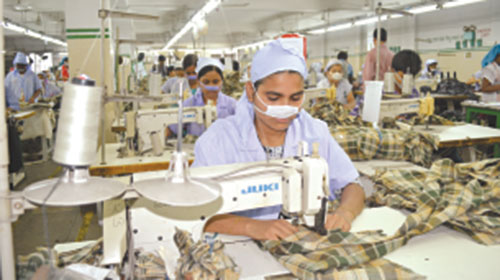Published in New Age on Sunday, 2 March 2014.
Apparel exporters eye more stride in alternative markets
Moinul Haque

Garment manufacturers have turned their focus on getting more stride into the non-traditional market buoyed by recent success and against the backdrop of tough conditions frequently being imposed by the EU and the US — the two major export destinations.
According to exporters and experts, despite being the second largest apparel exporter in the world, Bangladesh is still at a risk as the lion share of total garment exports of around $22.50 billion is concentrated in only the two markets.
The garment exporters are going to arrange a number of home and away single-country trade fairs targeting buyers in India, China, South Korea, South Africa, Mexico, Brazil and Chilli.
A such exposition — Bangladesh-India Fair for Garment Export — will be held in April 8-9 in Dhaka and a good number of apparel buyers, buying house representatives, trade body representatives and other related traders from India have been invited in the event.
The Bangladesh Garment Manufacturers and Exporters Association has a plan to arrange another single-country trade fair in China by June.
‘To ensure sustainable business we want to reduce the dependency on traditional markets and to achieve the goal in new market exploration is very much important,’ Bangladesh Knitwear Manufacturers and Exporters Association vice-president Mohammad Hatem told New Age on Saturday.
According to him, the brands and buyers in the traditional markets impose tough conditions frequently on the manufacturers in Bangladesh and at the same time they bargain for cutting prices of products as the country’s export depends only on the US and EU markets.
‘If we can increase the volume of exports to the new markets, the bargaining capacity of manufacturers on prices will increase while the sector will get relief from the dependency on the traditional market,’ Hatem said.
He said the apparel exporters had taken a move to organise single-country trade fairs in the Latin American countries as part of the move for market diversification.
‘As the major buyers of Bangladeshi apparel products, the US and EU can impose tough conditions. But I think the new markets will not impose such kinds of condition,’ the BKMEA vice-president said.
‘If any economic turmoil hits the traditional markets, the garment business in Bangladesh might be disrupted. So market diversification is needed for the sustainability of the sector,’ he said.
Garment export to the non-traditional market that included 11 countries — Australia, Brazil, Chile, China, India, Japan, South Korea, Mexico, Russia, South Africa and Turkey — has increased manifold in recent years.
In the first half of the current financial year exports soared by 37.27 per cent to $1.36 billion in the new market against $996.89 million of the same period of the last financial year 2012-13, Export Promotion Bureau data showed.
BGMEA vice-president Shahidullah Azim said that they were moving forward to hold single-country fair in India and China as there were enormous export potential there because of their huge domestic consumptions.
‘With the existing market we get sufficient orders in eight months but if we can explore new markets in Latin America and South Africa, the flow of orders will remain same throughout the year as when there is winter in the US, the summer season prevails in Latin America and South Africa,’ he said.
Azim thinks that alternative markets will be comfortable for the exporters as at the initial stage they will not impose tough conditions like traditional markets.
‘And in the meantime, manufacturers will be able to make their units compliant gradually,’ he said.
‘The market diversification will help manufacturers reduce dependency on selected markets and it will also increase the bargaining power in setting product prices,’ Azim said.
Centre for Policy Dialogue executive director Mustafizur Rahman said the move for market diversification was very positive for the country and it would reduce the risk of readymade garment export in the traditional market.
‘The huge domestic consumption of India and China could be a great opportunity for Bangladesh and if we can expand our business in the countries, our competitiveness on some selective items will increase,’ he said.
Mustafiz said that the potential of south-south trade had increased and Bangladesh would have to avail the opportunity of the growing market.
He suggested the manufacturers ensure synchronisation between supply and demand in the alternative markets.



